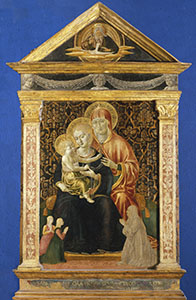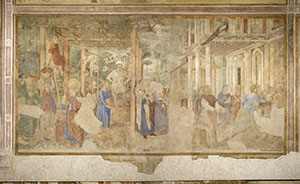
The Madonna and Child with Saint Anne and Donors, National Museum of Saint Matthew, Pisa.

The Vintage and Drunkenness of Noah, Camposanto (Graveyard), Pisa.
Although almost completely destroyed during the bombings of 1944, Benozzo’s most important work in monumental terms remains the great mural cycle he painted between 1468 and 1484 for the Camposanto (Graveyard) in Pisa.
Even at that time, the Camposanto (Graveyard), where precious Roman sarcofagi co-existed with frescoes by the most renowned fourteenth-century painters, was considered one of the great wonders of Italy. It was said, in fact, that the earth in which the dead were laid to rest came from none other than Mount Calvary. The people of Pisa, well aware of this treasure, insisted that only a highly prestigious artist must be engaged to paint the twenty-six frescoes required to decorate it, demonstrating, once again, the high regard and esteem in which our painter was held.
In accordance with the custom of the time, Benozzo enlisted the help of numerous co-workers to complete this vast work, and this allowed him to take on new commissions. One of these was the altarpiece, dated 1470, produced (probably by his studio) for the main altar of the Church of San Lazzaro (Saint Lazarus) outside the walls, also commissioned by Pisa’s Opera Primaziale (the lay institution responsible for the construction of the Cathedral and Camposanto (Graveyard) monumental buildings, officially recognised in 1217), now housed in the institution’s museum. Others include the back of the Bishop’s chair in the Cathedral, now in the Louvre (a work of a highly doctrinal nature given its intended use and its depiction of the Triumph of Saint Thomas Aquinas, a subject very dear to the Dominican’s and the Church in general), and the small devotional altarpiece depicting the Madonna and Child with Saint Anne and donors, now housed in the Museum of St Matthew, originating from the Dominican convent of Santa Marta (Saint Martha).
In order to work on the Camposanto (Graveyard) site, Benozzo and his family moved to the ancient maritime republic of Pisa, buying a house near Piazza dei Miracoli (Square of Miracles). However, during the summer of 1479, due to the plague that raged all over Tuscany, the situation in Pisa had become critical. For this reason, the painter decided to relocate to the countryside outside Pisa, taking up residence in Legoli, a small outlying hamlet of what is now the municipality of Peccioli in the Era Valley. There, he worked on a magnificent tabernacle, frescoed on all four sides, which still stands at the entrance to the village. During his stay there, Benozzo was called to Volterra to decorate the chapel of the Virgin in the Cathedral. The chosen subject was the Procession of the Magi, which he set to work on assisted by his studio of artists.
Having returned to Pisa and completed the frescoes for the Camposanto (Graveyard), he received new engagements including a lost cycle recalled by Vasari in his Lives (1568), created for the nuns of San Benedetto in Ripa d’Arno. For the same church, he frescoed a niche with the Virgin with Saint John. This fresco has now been removed and is housed in the rooms of the old nunnery, now home to the Cassa di Risparmio (Savings Bank) of Pisa. During this same period, in around 1490, he painted the altarpiece depicting the Holy Conversation for these same nuns in Ripa d’Arno. The panel, now in a poor state of repair due to careless restoration work in the past, is housed in the San Matteo (Saint Matthew) National Museum in Pisa together with a Crucifixion and Saints frescoed for the refectory of the Dominican women’s convent. While perfectly settled in this city, which was proud to host him, Benozzo always maintained strong links with his home town of Florence. This patriotic love is clear from the way he consistently defines himself as "Florentine" in the inscriptions and signatures affixed to his works, and also manifested itself in his activities with the company of Florentines residing in Pisa, for whom he painted the altarpiece for the main altar of the chapel, now housed in the National Gallery in Ottawa.
During this second period in Pisa, according to the scholar Padoa Rizzo, Benozzo may also have produced the round-topped panel painting in the Parish of Calci, depicting the Virgin and Child, originating from the Dominican convent in Poggio.
Serena Nocentini